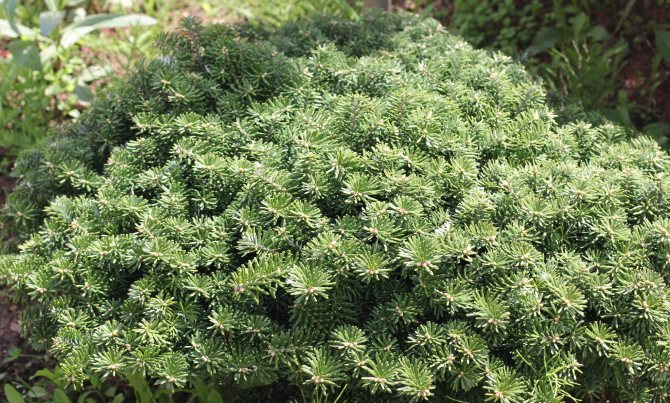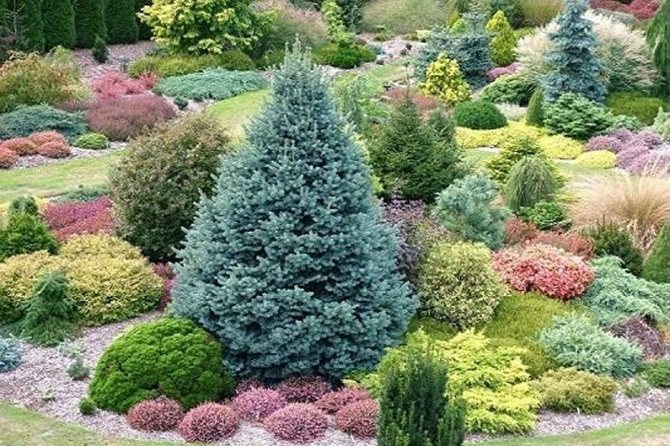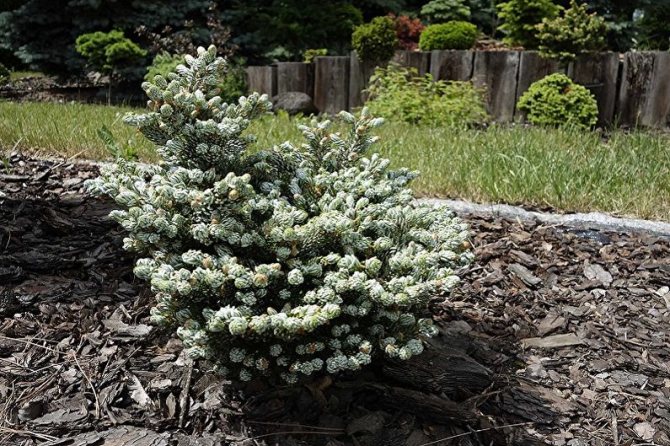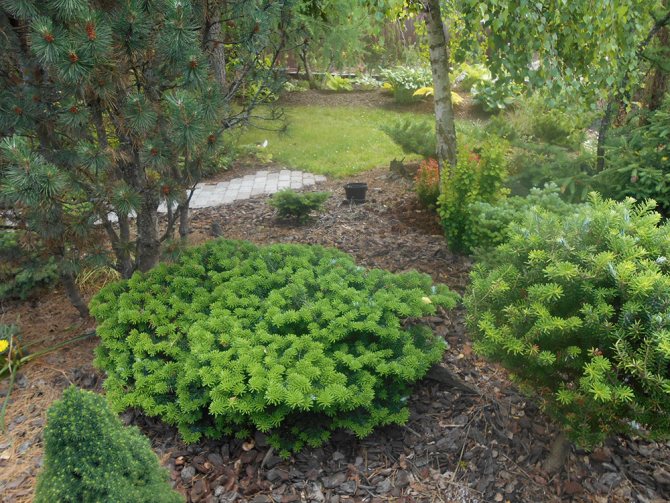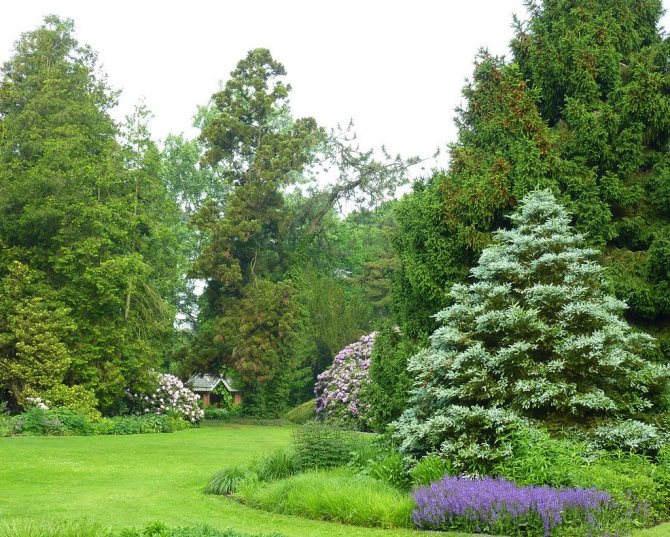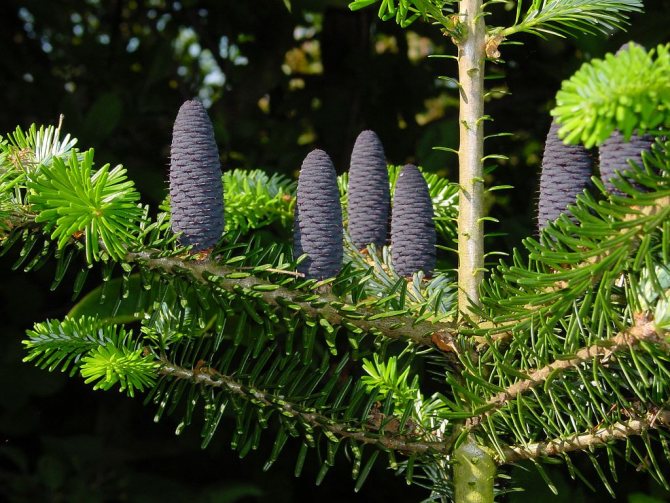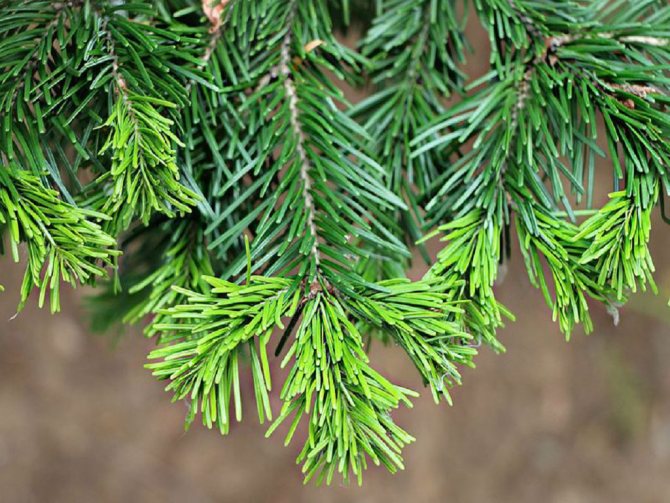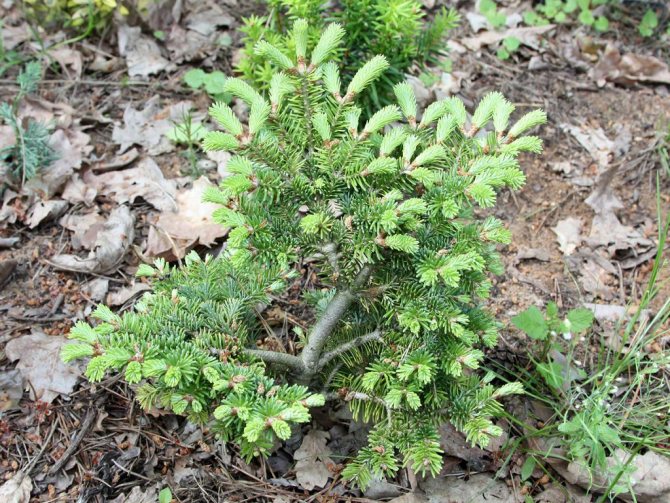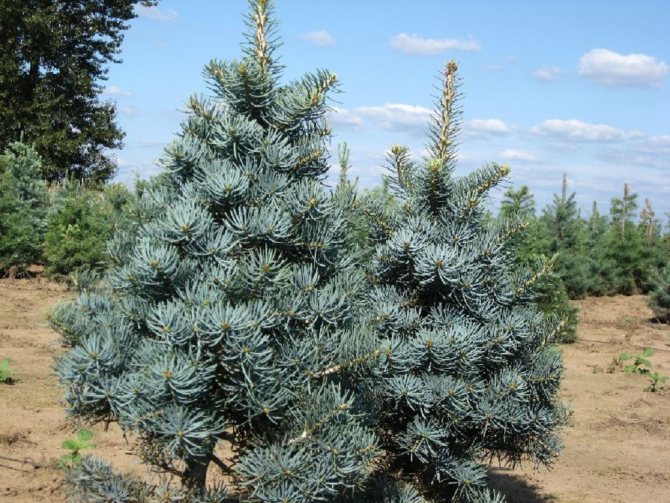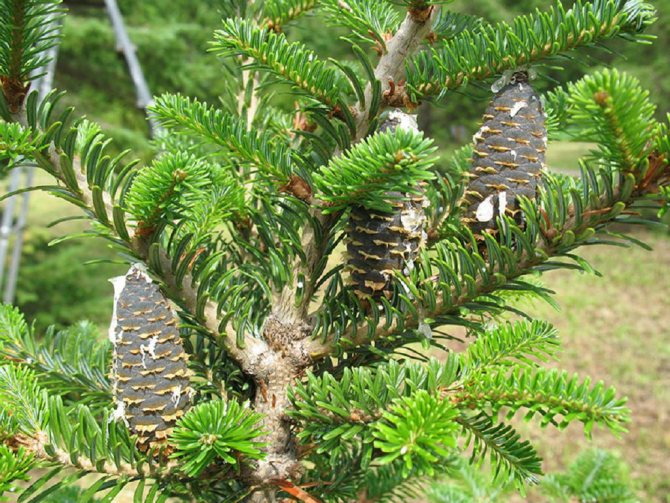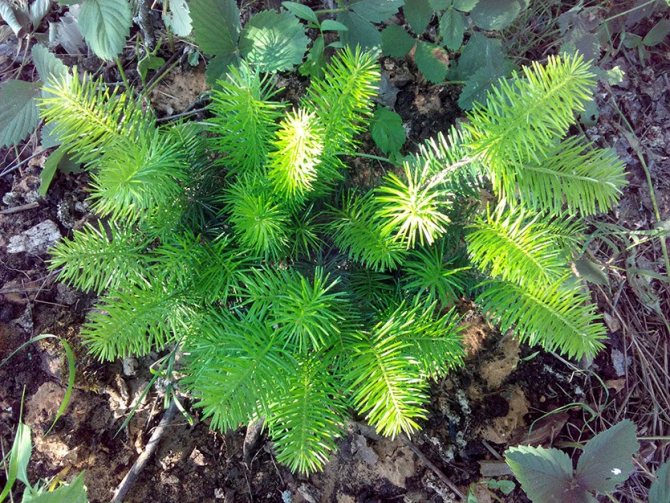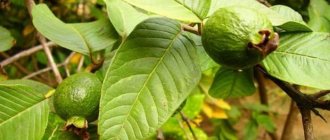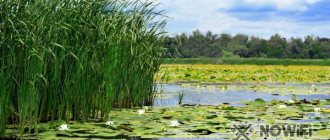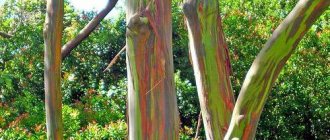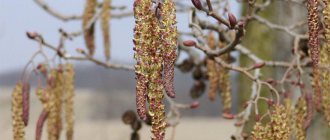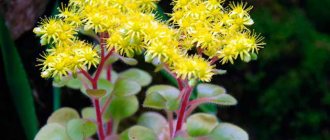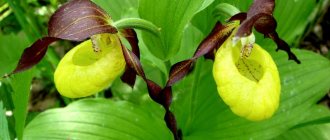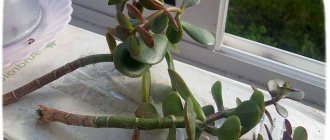Fir (abies) is an evergreen tree or shrub from the Pine family. Outwardly, the plant is very similar to a spruce, and in structure and direction of growth of cones - to a cedar. Most of the representatives are distributed from the tropics to the Arctic Circle of the Northern Hemisphere. The largest number of fir is concentrated in the west of Canada, the USA and in East Asia. Depending on the type of fir, they are thermophilic or frost-resistant, but all are sensitive to drought and stagnant water. Fir is used in the woodworking industry, landscaping, as well as in folk medicine.

Here you will find out:
Botanical description
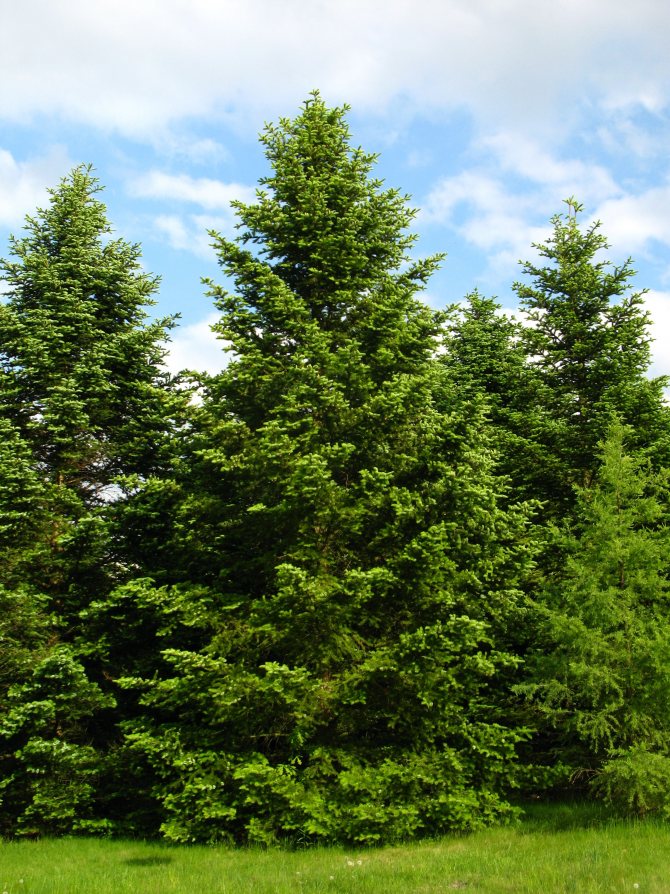

Fir is classified as an evergreen coniferous plant. It belongs to the Pine family. In total, 50 of its species are known in the world. They mainly grow in the northern hemisphere, preferring the temperate zone. Siberian fir is the most widely used as a raw material for medicines. In appearance, the plant is quite easy to distinguish. Just look at the cones that resemble candles on a Christmas tree.
Common fir is capable of giving a large shade and transmitting little light. Forest fir blooms at 70 years old. If it grows in an open space, it happens in the fortieth year of life. It develops rather slowly. In the future, its growth is accelerated. Fir is a tree that can live up to 500 years, some species live up to 700 years.
origin of name
The name of the plant in question has an ambiguous history of origin.
The etymology of the word "fir" can be considered according to the following options:
- the Latin name of this coniferous tree is "Abies", which originates from the Indo-Germanic word "abh" ("to abound"), which confirms the fact that the fir is densely covered with needles.
- The Russian-language version of the name comes from the Karelian word "pihka", meaning "resin".
- Vasmer's research speaks of the German origin of the word - "Fichte" is translated as spruce or pine; this version of borrowing was supported by A. Matzenauer and A. Preobrazhensky.
- this name can also come from Western Finnish languages ("pihk" - large forest, "pihku" - pine); this assumption arose on the basis of V.A.Merkurov's research.
- Arkhangelsk dialects interpret the word "fir" as "small spruce thicket"
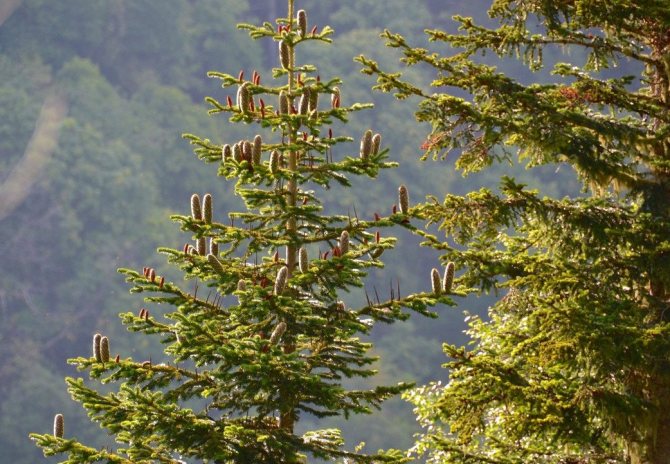

Plant classification
Fir is a dioecious plant. On each individual, both female and male reproductive organs can be found. Fir is distinguished:
- Siberian.
- White.
- Nordmann or Caucasian.
- Korean.
- Fraser.
- Balsamic.
The buds of this plant grow vertically. They can ripen from June to August and fall off in autumn or winter. In this case, the seeds are released. A notable feature of fir is considered to be that it is able to reproduce by layering. Basal babies are located close to the soil surface. In contact with the soil, they take root and grow roots. A separate tree grows. Like spruce, it provides significant shading.
Siberian fir
Siberian is considered the most common of all varieties growing on the territory of Russia. Description of fir:
- It grows to a height of 40 m.
- The crown is narrow, conical.
- The barrel has a cylindrical shape at the top. Its diameter is 0.6 m.
The wood is almost white, in some places it is light yellow. The branches, although thin, are capable of sinking to the ground in the absence of obstacles. Young crops are covered with needles since August. The tree has a central root that extends deep into the ground. A large number of lateral shoots comes from it.
Due to its powerful root system and columnar crown, Siberian fir is able to endure strong winds. On moist soil, it forms a superficial root system. Mycorrhiza is often found on the roots. The bark of a plant has such characteristics as:
- dark gray tint;
- fine structure;
- smooth surface.
You can see special moves on the bark. There is a thick aromatic sap here. Her taste is bitter. It is called fir balsam. On one tree, you can see up to 600 such formations, differing in size. The buds that form at the ends:
- resinous;
- oval;
- outwardly resembling a ball.
Growing persimmons from seeds at home
They are protected by a large number of resinous layers. The processes are yellowish-gray with light stripes. Spirally growing formations can be found on the branches. They are thin, curved, straight, thornless, ring-shaped. They may have an emerald-colored groove in the central part. They are characterized by a coniferous smell. They are 3.5 cm long and 0.2 cm wide.
On the reverse side of the needles there are 2 white stripes. They are distinguished by a waxy layer. Each such needle can live up to 12 years. When it falls off, flat marks can be seen on the branches. It is surprising that the fir does not shed its needles, even if its branches dry up. That is why they buy it for the New Year, because the spruce needles instantly fall off when they dry.
The lower branches of fir often reach ten meters in length. They grow to the sides and grow their roots. Breaking away from the bark, they are able to live independently for a long period. In this case, the so-called dwarf fir is formed.
Siberian fir begins to bloom in late spring. Its key reproductive organs are spikelets. Male ones are bright yellow, characterized by the shape of an ellipse and grow up to 0.8 cm. Pollen is formed in them. An air cavity is found in every speck of dust. Due to this, male dermatophytes overcome considerable distances. In the event that the male shoot stops producing pollen, it dies.
Female organs for reproduction are cones of a dark scarlet hue... They are formed on green shoots that have formed from the previous season. They grow vertically upward. The bumps grow in a spiral in the sinus, they form two ovules. By the time the seeds are formed, the cones acquire impressive dimensions and reach a length of 10 cm. They have a light brown tone.
With the onset of September, the cones disappear. Scales come down with them, while the pineal core is present on the branches for a long time. These cones from fir have characteristic differences from cones of non-conifers. To use Siberian fir for medicinal purposes, they store:
- kidneys;
- young shoots;
- bark of plants;
- needles.
The kidneys must be harvested in the second decade of April. The branches are laid in May when they can be harvested in any season. Young fir needles are removed twice a year. This is done in the summer and from the end of autumn until February.
White fir
It is also called European. It grows in height up to 65 m. Its trunk reaches 2 m in diameter. Lives up to 300-400 years. In a young plant, the crown is pyramidal and elongated. Gradually, it becomes somewhat pointed, oval. In old trees, the top becomes dull over time. The bark is smooth, brown in color. Branches are located with a slight horizontal angle.
The needles grow up to 3 cm and 3 mm wide. On the branches, the conifers are parallel. Their tips have a slight indentation. From the front, they are deep green, glossy, and on the opposite side, you can find white pores. Young white fir cones are green. Ripening, they acquire a dark brown color and become oval. They reach 4 cm in width.
As with most of the existing varieties, in this species, the buds ripen in September and October and lose their scales. White fir has seeds that are quite large in thickness and length. Their size reaches 1 cm in diameter. The root is taproot, extending deep into the ground. Lateral roots emerge from it, rather thin in structure.
Caucasian view
The Nordmann fir is a species that grows up to 50 m in height. The trunk can be up to 2 meters across. The crown has a triangular shape. This tree is called the Apollo fir, as well as the Caucasian fir. And it is also often said that this is a Trojan horse tree. There is a legend that this particular breed was used to make the famous object.
In what conditions and where does the pomelo fruit grow?
Now the tree is popular with Europeans, who use it to celebrate Christmas. Places of growth of this species:
- in Asia Minor;
- in the mountains of the Caucasus.
His life span is up to 600 years. The needles bloom late. The plant has bright green needles with white stripes on the back. As the needles mature, their color changes to dark green. The bark is dark and smooth in younger years. As she grows up, she is able to turn brown.
The Nordman fir blooms in early May. The cones of this breed are cylindrical or elliptical. Male cones are red, female cones are green at first, turning brown after ripening. The roots go deep into the ground. Caucasian fir grows well on loose soil. The tree grows fairly quickly and can thrive in shaded environments. It is distinguished by its demanding humidity and is able to withstand extreme temperatures down to -25 degrees.
This type of fir can be used as an ornamental tree. The most common hybrids are:
- Jadwiga is distinguished by its rapid growth and impressive height. Her needles are long, rich green, on the back side - bright white. The crown is dense and dense.
- Golden Sprider is a miniature variety. In the center, the crown has a characteristic depression. It grows slowly. It can grow up to 1 meter in ten years. On the outside, the needles are glossy, golden. On the reverse side - light yellow, matte. It is planted in rock gardens.
- The Pendula variety develops slowly. The crown in it is elongated, bright green, the plant prefers an average level of humidity. It is susceptible to mechanical stress. Such crops can be planted in arboretums and in personal plots.
Korean hybrid
It is a variety that grows to a height of 15 m and has a conical crown. The bark of such hybrids is smooth, often has a red tint, light gray. In adult specimens, it is rough, covered with a symmetrical pattern. The needles have a dense cover on the branches. Some species can grow up to 0.25 cm wide. They are dark green on the surface, strong, on the lower side - glossy have two white borders.
Description of monochromatic fir and its varieties
Cones are cylindrical in shape. Once ripe, they turn purple. In natural conditions, this variety lives in the southern part of the Korea Peninsula. He likes the highlands, at elevations from 1 to 2 km above sea level.
Other decorative types
Fraser fir - up to 12 m in height and 50 cm in length... Her crown is conical. In natural conditions, it lives in North America. The needles are fluffy, silvery underneath. It has tiny bumps and bent scales. Feels good even in severe frosts.
Balsam fir reaches 25 mm in height.The top is triangular and can go down to the very bottom. Lives up to two hundred years. The plant has a gray-brown bark that is smooth. Needles - up to 22.5 cm in length, have a notch at the ends and are blunt. From the facial area, they are deep green. On the back - glossy. Have whitish lines.
Cones are round, cylindrical, can reach 0.25 cm in width. The roots are shallow. The growing area is in North America. She especially likes East Central Canada and Alaska.
Care and cultivation of Korean fir
For rooting and growing a tree, it is better to buy a seedling in a specialized reserve where healthy plants are sold. Such cuttings are already adapted to the climate, it is much easier for them to adapt to the type of soil, temperature changes and other factors of the area.


If you plan to grow ephedra in the Moscow region, you need to take into account that most of the territory is located in a cold climatic zone.
Therefore, it is necessary to select varieties of Korean fir that can grow at temperatures up to -29 degrees. When planting less resistant varieties of the tree, there is a high probability that the plant will freeze in winter, freeze the apical shoots.
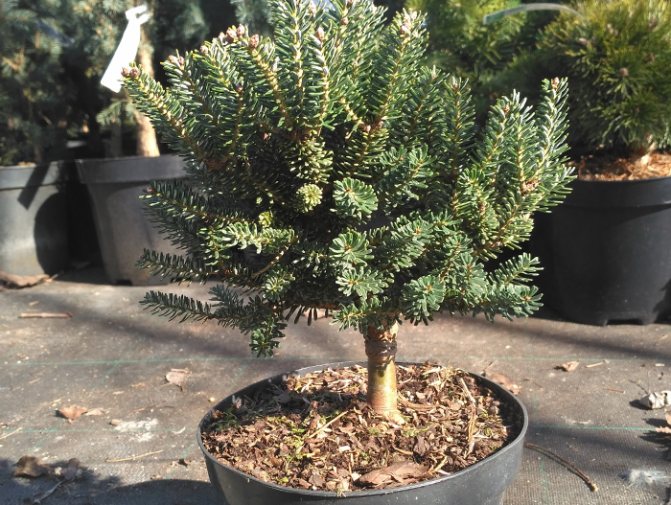

They need to be covered in cold climates.
Planting Korean fir
Seedlings less than 4 years old become optimal for rooting, they can normally adapt to growing conditions. The disembarkation is carried out in early April.
The preparation of nutrient soil and drainage becomes a mandatory measure. The most suitable type is considered to be a loamy substrate.


It is also possible to plant a plant in early autumn. With proper work, the seedling will take root until frost.
Recommendations for planting conifers:
- The hole for the plant should be 50/60 centimeters in diameter / depth, but it is necessary to take into account the dimensions of the seedling, the root system. The fossa must be left for several weeks.
- A hole is spilled with 2 buckets of water, after which soil is dug up, drainage is laid with a thickness of about 7 centimeters.
- Pour soil (compost, clay, peat, sand 3: 2: 1: 1) into the hole, and also fertilize 10 kg of fine sawdust, 250 grams of Nitroammofoska.


- You can plant a coniferous culture in 3 weeks. An elevation is formed in the fossa by means of a nutrient substrate.
- A plant is established with straightened roots, while it is impossible to remove the earthen lump in which the seedling grows. The junction of the rhizome and the trunk is located at ground level.
- The voids are covered with soil, compacted.
- They carry out abundant watering of the plant, mulch.


The optimal distance between fir seedlings is 2.5 meters. After planting, it is not watered for some time, it is protected from the scorching sun.
Beneficial features
For the preparation of medicinal drugs in folk medicine, Siberian fir is used. Fir balsam is a raw material for a whole range of useful products. It contains organic acids, resins, turpentine. Fir balsam is also called resin. It is 70% resin and 30% essential oils. The wood contains 4% of essential oil, 80% of it is camphor.
In the roots, it is found in the region of 8% essential oil. Its composition is represented mainly by camphor. In addition, fir oil contains acetaldehydes and organic acids. The seeds contain 30% fatty oils. They contain a lot of vitamin E. The bark contains quite a lot of tannins. They are present up to 13%. The so-called sap is present in the greatest quantity. Its content reaches 16%.
Wood oil and its composition
Fir oil differs in volume and composition, depending on the particular tree. Moreover, its quantity and various characteristics change throughout the year.The needles are most rich in essential compounds at the end of May and after the end of the growing season. It is interesting that the crust during the indicated period, on the contrary, contains a minimum of ethers. Speaking about the qualitative composition of fir oil, it is necessary to indicate the key component bornyl acetate. It is able to reach its maximum concentration in late November and early December.
The substance that is most important to humans is bornyl acetate. It is borneol and acetic acid ester. In addition, all parts of the tree contain tannins, tocopherols, carotene. Half of the fir resin consists of hydrochloric acid.
Tannins are used to combat poisoning with lead and mercury compounds, morphine and cocaine. Their action is aimed at relieving inflammation. These compounds have long been used in medicine. Tannins have antimicrobial action against various infectious agents. In addition, it is also a good component of antidote therapy for winged insect bites.
Purple willow Nana in landscape design, her planting and care
Ascorbic acid in the product is one of the best antioxidants. And also this substance is actively involved in the production of collagen and steroid hormones serotonin, el-carnitine. Synthesis of some pigment substances is impossible without ascorbic acid. In addition, it normalizes the secretion of bile and puts in order the secretion of internal and external glands. Carotene is an antioxidant and protects cell membranes from destruction. It is responsible for twilight vision, just like vitamin A.
Fir needles
This part of the plant contains 3.5% essential oil. It is used for the production of camphor. Fir needles contain carotene and phytoncides. It is also rich in flavonoids. Phytoncides have antiviral and antimicrobial effects, therefore they are recommended for use in ARVI and colds.
Fir phytoncides are so powerful that they can sometimes be more effective than antibiotics. Flavonoids can degrade if stored improperly. They have a whole range of properties. Among them: vasoconstrictor, immunostimulating and detoxifying.
Fir needles contain iron, which is essential for the production of hemoglobin. This mineral is involved in the laying of DNA, therefore it is necessary for the reproduction and growth of cells. In addition, it plays a critical role in protein metabolism. Zinc prevents early aging, has a wound healing effect. He is directly involved in the formation of individual enzymes and is necessary for the growth process. Cobalt stimulates the growth of red blood cells, provides oxygen transport to cells, promotes better absorption of iron by the body, and has a positive effect on the central nervous system.
Reproduction methods
Fir is propagated using seeds and cuttings. The seed method is more suitable for species plants. Seeds are harvested at the beginning of the ripening stage. This can be done while the buds have not yet disintegrated and the seeds have not scattered over long distances. They are dried and the seed is removed. Until next spring, the seeds are left in a cloth bag. In order for them to undergo stratification, the bag is placed in a refrigerator or basement for several months. In mid-spring, they are planted in open ground. For this, a garden bed is prepared. Garden soil is mixed with turf and sand. The seeds are buried 1.5-2 cm, and then covered with foil. Seedlings appear in 20-25 days, after which the shelter can be removed. Watering and loosening is carried out regularly. It is important to remove weeds in a timely manner during the first year. For the winter, fir seedlings are covered with spruce branches. In the spring, they can be transplanted to a permanent place. Plants develop slowly at first. The annual growth is up to 10 cm.
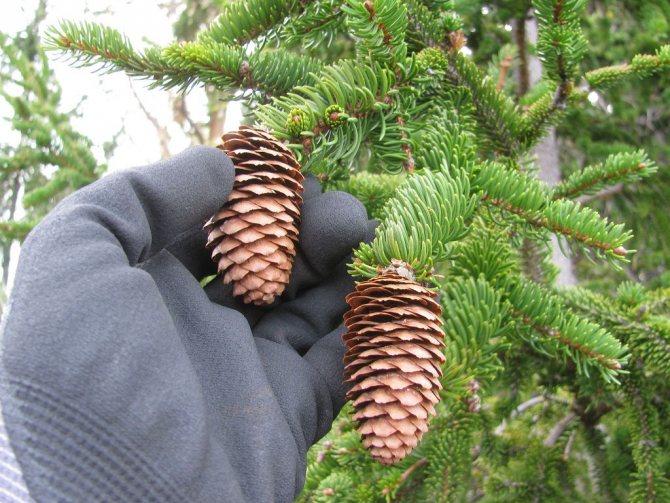

It is customary to propagate varietal fir by cuttings.For this, annual shoots from young individuals are used. The length of the cutting should be 5-8 cm. It is important that there is a single bud at the top, and the heel (a section of the bark from the mother plant) is preserved at the base. Cuttings are harvested in early spring, before sap flow begins. It is better to do this at the beginning of the day in cloudy weather. 6 hours before planting, the shoots are soaked in a fungicide solution to prevent fungal infections. It is important to ensure that the bark does not separate from the wood at the heel. Planting is carried out in pots filled with a mixture of leafy and humus soil and river sand. The seedlings are covered with a transparent film, which should not come into contact with the top. For better rooting, lower heating is organized so that the soil temperature is 2-3 ° C above room temperature. The containers are placed in a place with bright, diffused light. Every day you need to ventilate the cuttings and moisten the soil as necessary. Since May, they are exposed to fresh air, and for the winter they are taken back to the house. A full-fledged rhizome develops in a year.
Application in the treatment of diseases
Siberian fir has many positive properties. It includes substances that have a beneficial effect on health, biologically important components and vitamins. Needles are considered a source of ascorbic acid, which has antioxidant properties. Vitamins in the composition of plant materials contribute to the breakdown of toxins and their elimination from the body.
Phytoncides effectively fight viral agents, accelerate the healing of injured skin surfaces and regulate the production of digestive enzymes. And also the presence of needles in the room can disinfect the air, eliminate bronchospasm and alleviate the course of most diseases of the upper respiratory tract. Due to its expectorant effect, fir can be used to clear the respiratory tract with a wet cough.
Fir cones are used to treat rheumatism and other joint diseases. Most often, they resort to using a steam bath for the feet. Pour boiling water over the cones for this purpose and keep their feet above the steam, while covering them with a dense cloth.
Fir branches contain a lot of essential oils, which is why they are used to make fir oil. Decoctions and infusions are used in the fight against diseases of the respiratory system. Fir extract has antiulcer and hepatoprotective effects.
Interesting Facts
The culture is very beautiful, unusual, it stands out among other evergreen perennials. Interesting that:
- Fir twigs make good brooms for a bath.
- The needles are rounded, do not prick, have a pleasant spruce aroma.
- Fir cones grow vertically upward.
- For the first decade, the seedling develops very slowly, then faster.
- The breed has a peculiar attitude towards light. Loves shaded places, she forms a large shadow.
- The fir tree propagates by layering.
- Cones of both sexes grow on the same tree.
- Does not tolerate smoke and polluted air.
- The phytoncides contained in the fresh paws of the breed disinfect the room.
- Fir oil is used to produce camphor.
- About 9 varieties of this culture grow on the territory of the Russian Federation.
Fir is an evergreen coniferous perennial. The plant is demanding in terms of growing conditions. Varietal diversity is represented by trees that differ greatly from each other in terms of their external description. Propagated by seeds from cones and layering.
Taxonomy
A photo of Korean fir, the description of which should be considered before buying, can be studied further. This tree was first included in the classification of conifers in 1907. Its description is similar to that of other members of the family. However, there are also a number of obvious differences.


The official name of this plant is Abies Koreana. The tree belongs to the class of Conifers. She belongs to the large Gymnosperms section.Also Abies Koreana is a member of the Pinaceae family (translated as Pine). The plant got its name exclusively due to the place of its growth.
Over time, fir began to be grown in Europe and Russia. The tree is adapted to the climatic conditions of the middle zone of our country. Therefore, it is actively grown in different household plots. Due to the peculiarities of its development in the wild, the fir of the presented species has a powerful root system. This allows the tree to hold firmly on rocky terrain and withstand wind and weather.
How to properly dig a hole when planting?
It is necessary to dig a hole for the future plant, about 20 centimeters wider and 30 centimeters deeper than a clod of earth that protects the roots of the seedling. How to correctly determine the depth of a dug hole? It is easy to do this - put the handle of the shovel across the pit. It will serve as the defining level. Place a seedling with a clod of earth in the hole and look at the level, how deep the plant will be planted.
In no case should the root collar be buried, the first root of the seedling will grow from there after planting. This place only needs to be lightly covered with earth. Therefore, if you deepened the hole too much, then it is imperative to add earth or make a drainage layer. Broken brick can be used as drainage. Fir does not like it when moisture stagnates in the roots.
Varieties
Various varieties of Korean fir are grown in our country. They differ not only in appearance, but also in developmental features, requirements for environmental conditions. Experts say that by choosing a sort of fir at random, you can later greatly regret such a rash act.
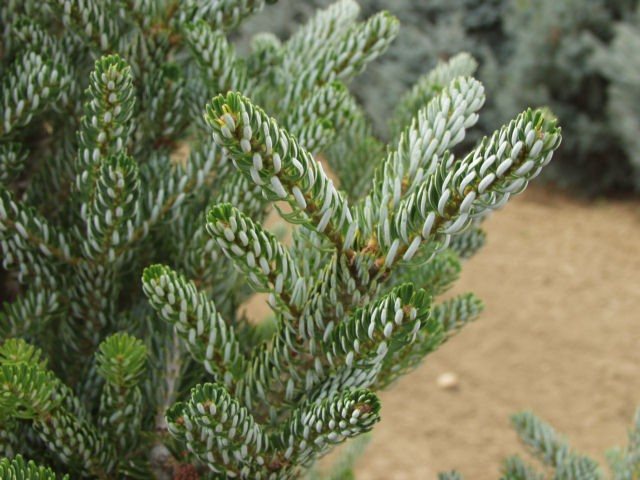

Site conditions must meet the plant's requirements for growing conditions. Otherwise, she simply will not be able to develop here and will die. Also, existing varieties of fir of this species can vary significantly in size. There are tall and undersized trees.
Varieties may visually differ in the shape of the crown, the color of the needles. The shape of the cones also varies. This plant is planted for decorative purposes. It is also capable of providing a large amount of oxygen to the site. In order not to be mistaken in the choice, you need to consider the features of the most popular varieties.
Content:
- Fir Brilliant
- Fir "Blue Standard"
- Fir "Brevifolia"
- Fir "Dark Hill"
- Fir "Oberon"
- Fir "Silberzwerg" ("Silberzwerg")
- Fir "Cis" ("Cis")
- Fir "Tundra" ("Tundra")


Homeland of this type of fir is South Korea, but it quickly spread throughout the world, and new beautiful varieties have appeared. Breeders love Korean fir and today there are dozens of varieties, among which we have selected the most popular and beautiful ones.
Spread
Fir lives in almost any region. The culture is found in the southern and northern regions, countries with tropical, subtropical and temperate climates. In some regions, there are fir forests, which occupy about 20 million hectares of the entire area. The culture is planted in regions with a northern climate. You can meet the varieties in Mexico, El Salvador. In Russia, fir is found in almost all regions. In Siberia, fir lives in the Northern Hemisphere, along the banks of the Yenisei River.
Fir is an unpretentious plant that lives in coastal areas and in mountainous areas. Various types of crops are highly resistant to frost and can easily tolerate drought. Fir can grow both as a separate crop and as fir forests. The culture is not demanding on living conditions, but it grows only in places with fertile soil.
Low-growing varieties Compact and Blue Emperor
Low-growing varieties of Korean fir are Compact and Blue Emperor. The first of these plants belongs to the category of dwarf trees. It reaches a height of 80 cm.The shape is symmetrical, beautiful. The color of the needles is blue. There are practically no bumps. The variety loves open areas and lots of sun. The compact grows well on clay soils. This variety can beautify any area.
The Blue Emperor variety is characterized by a somewhat larger size. This plant grows to a height of 1.5 m. This is a good option for both small and spacious areas. It is the only fir variety of this type that prefers to grow in the shade.
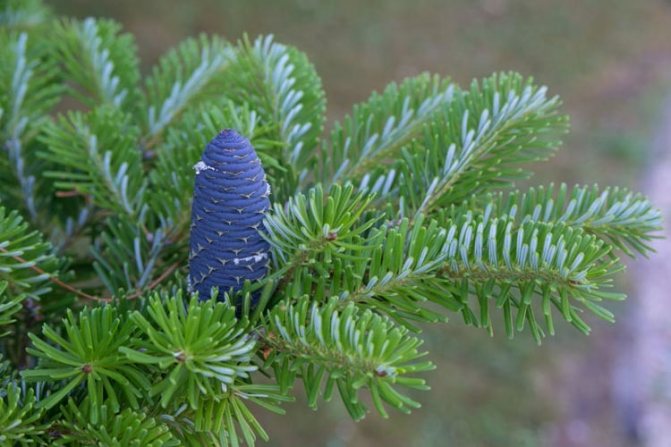

The needles of the Blue Emperor variety are very dense, but short. It is soft and pleasant to the touch. Has a purple tint. This gives the tree an unusual look. The buds also have a similar shade. They can be purple or bluish. This variety is not afraid of the wind. It is planted even next to fruit plants. This fir protects other trees from the winds.
Pruning
Nature has endowed the fir with a very beautiful crown, as a rule, this plant does not need pruning. Unless in the spring, after winter, you will notice a broken twig or dried out, as a result of some kind of physical impact. For example, there was too much snow, and the branches of a young tree could not withstand the load.
If the fir grows and develops in conditions suitable for it, then the plant's immunity will be strong. The tree will not suffer from diseases or pests. However, if the plant was stressed, for example, during a hot dry summer there was little watering and the branches dried up, the needles began to fall off, such a plant may be affected by diseases.
Fir usually suffers from fungal diseases. Damp, warm winters are especially favorable for the appearance of fungus. You can fight this, use special drugs.

